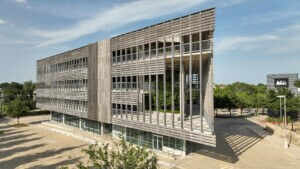The idiom “can’t see the wood for the trees” is rarely—if ever—applied in a literal sense. Researchers at Stockholm‘s KTH Royal Institute of Technology however, may have found a genuine excuse to do so. An article published in the American Chemical Society journal Biomacromolecules reveals that the research team has developed transparent wood.
According to Lars Berglund, a professor at Wallenberg Wood Science Center at KTH, this transparency is achieved by chemically removing the wood’s lignin, a structural polymer found in the cell walls of plants that gives wood its brown coloring. It also stops up to 95% of light from passing through. “When the lignin is removed, the wood becomes beautifully white. But because wood isn’t naturally transparent, we achieve that effect with some nanoscale tailoring,” explained Berglund.
In a press release, KTH said this “nanoscale tailoring” involves impregnating the wood, or “white porous veneer substrate” as it’s technically called, with a transparent polymer. As result, light can pass through the material more easily and the ‘wood’ becomes transparent.
The American Chemistry Society reports that the subsequent material is twice as strong as plexiglass. “It also offers excellent mechanical properties, including strength, toughness, low density, and low thermal conductivity,” adds Berglund. However, there has been no publication on the materials properties pertaining to how it will react when exposed to water, fire, or extreme temperatures. Despite this, the case for see-through timber (pardon the pun) is clear. Berglund advocates for the material being used for windows and semitransparent facades, with the aim to “let light in but maintain privacy.”
“Transparent wood is a good material for solar cells, since it’s a low-cost, readily available, and renewable resource,” Berglund continued. “This becomes particularly important in covering large surfaces with solar cells.” Prior to the development, Berglund pointed out that transparent structures were yet to be considered for use as solar cells in buildings. Now he and KTH have set their sights on improving the transparency of the wood and producing the material in larger quantities.










